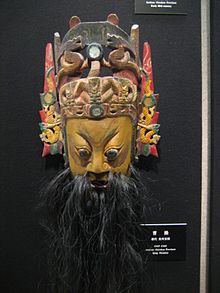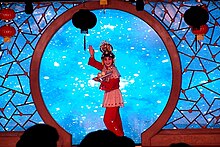Drama (china)

The drama in China ( Chinese 中國戲劇 / 中国戏剧 , Pinyin Zhōngguó Xiju - "Chinese drama") refers to traditional Chinese forms like the musical theater and the introduced only in the 20th century, European and Japanese spoken theater . Known as Chinese opera nowadays are e.g. B. Peking Opera and Kun Opera .
history
Yuan time

The Chinese music theater, which in the 12./13. Century in different forms, showed a number of influences of earlier art forms that went into the music theater. Song and dance appeared in early Chinese history, poetry also played a role in this period and was then particularly emphasized in Chinese culture. Other influences like comedy and duel then appeared in the Han period . Storytellers have been particularly popular in markets since the Tang period . In the Yuan period , literary officials who had lost their offices under Mongol rule became dramatists who wrote text books in which lyrical singing was particularly important. This poetry was mostly recorded in writing, while spoken words often did not have the same meaning and were not always written down. In addition to singing, the texts of traditional music theater also contained detailed instructions for facial expressions, dance, acrobatics and spoken lecture. Such instructions have been handed down in fragments from the Song and Jin times and had their heyday as Zaju during the Yuan Dynasty. The Zaju was a Northern-style Singspiel, while the Nanxi, the Southern-Style Singspiel, was developing. Hundreds of works have come down to us from the Yuan period. During this time the theater was presented in three successive forms: As Zaju (Singspiel from the Mongol period), as Chuanqi (Singspiel from the Ming period) and as Difang Xi (local theater).
Apart from motifs from everyday life, the Zaju is shaped by popular historical subjects that come from historical chronicles and classical literature. The Zaju is therefore less about the generation of tension through unexpected action developments, but rather the emotional world of the people in a more or less known framework action is the focus. This also explains the great importance of the lyrical passages, in contrast to the ongoing action in spoken passages.
Ming time
During the Ming Dynasty , the drama of the Mongol period lost its importance and the Nanxi, the southern-style drama, evolved into the Ming (Chuanqi) drama. These dramas were larger and more complex than the drama of the Yuan period. A Chuanqi consisted of 40 to 50 appearances. Typical of the Chuanqi is a dramatic love story that depicts personal fates and power struggles in politics. An 'episode montage structure' is mostly used: the main theme is linked to one or more secondary themes, there are parallel storylines that connect the events of the main storyline around the main characters. This structure of action appeared very early, e.g. B. in the Chuanqi Pipa ji (The Lute) written by Gao Ming .
Since the 16th century, the Chuanqi dramas were mainly written for the Kunshan Qiang music style , which is why they are also called Kunqu (Kun Opera). At the same time, however, there were also pieces of other styles, which are designated depending on the place of origin.
Qing time
Chinese opera was narrated in a variety of works from the Ming and Qing periods . The titles of around 2,600 Chuanqi by different authors have been recorded and around 900 pieces have been preserved. In addition to the chuanqi, zaju continued to be written and performed. From the 18th century onwards, palace scribes appeared who wrote so-called palace pieces (Gongting Daxi) for the court. These made use of known materials and motifs from literature and history, such as B. the trip to the west .

Towards the end of the 18th century, dramatic literature fell sharply due to increased literary control. The Kun Opera was also affected and continued to deteriorate.
Instead of these operas, however, regional operas emerged, the local operas (Difang Xi), which used an abundance of new musical styles. Then in the 19th century there were diverse regional styles and pieces. These local operas mostly had anonymous authors, as they represented the work of a theater group or family of actors. Most of these dramas are existing works and subjects that were adapted for the local operas in terms of language, music and representation. The Peking Opera, for example, which became popular at the end of the 19th century , largely used historical material that was already available and was then made famous by a famous singer actor.
The modern theater
At the beginning of the 20th century, spoken theater (Huaju) was brought to China by Chinese intellectuals. This form of theater originated in Japan , where European and American models were used. Until the 1930s, mainly Western plays were played, after which Chinese writers such as Guo Moruo , Hong Shen and Tian Han also wrote Chinese plays. For a long time the Chinese spoken theater served agitation , which was justified by the connection to progressive and revolutionary movements, and the artistic and aesthetic demands were not particularly pronounced. Up until the Cultural Revolution , the theater was tied to socialist realism and there were few attempts to overcome it. B. by the Shanghai director Huang Zuolin . Simplified representations and moralizing attitudes characterized the Chinese theater.
During the cultural revolution there were hardly any forms of spoken theater, for the most part only the revolutionary model opera , which had emerged from the 'revolutionary, modern Peking opera ' and tried to deal with contemporary issues. The model opera was the binding role model for all local operas. At the end of the Cultural Revolution, due to political defamation by artists and cultural politicians, the opera's repertoire was so limited that there were only "8 model lopers for 800 million". The main aim of all of these model flops was to highlight triumphs of Mao Zedong's stance against other views in the history of the revolution. After the Cultural Revolution, however, spoken theater became popular again and the new plays were also devoted to coming to terms with the past and problems of reform policy and modernization .
From the 1980s onwards, the concept of theater was discussed for the first time in the People's Republic of China , whereupon the theater experienced a deep crisis. During this period, the Chinese theater was influenced by Western playwrights such as Beckett and Ionesco , and the plays had an experimental character.
At the end of the 1980s, a change began in which multi-layered characters were designed, questions were asked, and the need for political harmonization was partially abandoned. Nowadays, the Chinese theater is no longer fully ideological and has an abundance of different forms and contents.
See also
- Narration (China)
- Essay (China)
- Women's literature (China)
- Nature Poetry (China)
- Reportage literature (China)
- Roman (China)
literature
- Volker Klöpsch, Eva Müller (Ed.): Lexicon of Chinese Literature. CH Beck, Munich 2004
- Wolfgang Kubin : The traditional Chinese theater . From Mongolian drama to Beijing opera. In: Wolfgang Kubin (Ed.): History of Chinese Literature . tape 6 . KG Saur, Munich 2009, ISBN 978-3-598-24543-5 .
